Competitive Strategy Analysis of the Tourism Business Sector
VerifiedAdded on 2023/06/12
|7
|1867
|196
Essay
AI Summary
This essay provides a comprehensive analysis of competitive strategies within the tourism industry, utilizing key strategic development tools such as PESTEL analysis, SWOT analysis, and Porter's Five Forces. The PESTEL analysis examines political, economic, social, technological, environmental, and legal factors impacting the tourism sector, highlighting the influence of government policies, economic stability, social trends, technological advancements, environmental conditions, and regulatory frameworks. The SWOT analysis identifies strengths, weaknesses, opportunities, and threats within the tourism industry, emphasizing the importance of leveraging strengths and opportunities while mitigating weaknesses and threats. Porter's Five Forces model assesses the bargaining power of suppliers and customers, the intensity of competitive rivalry, the threat of new entrants, and the threat of substitute products or services, providing insights into the competitive dynamics of the tourism market. The essay concludes by underscoring the importance of these strategic tools in formulating and implementing effective strategies to achieve a competitive advantage in the tourism industry.
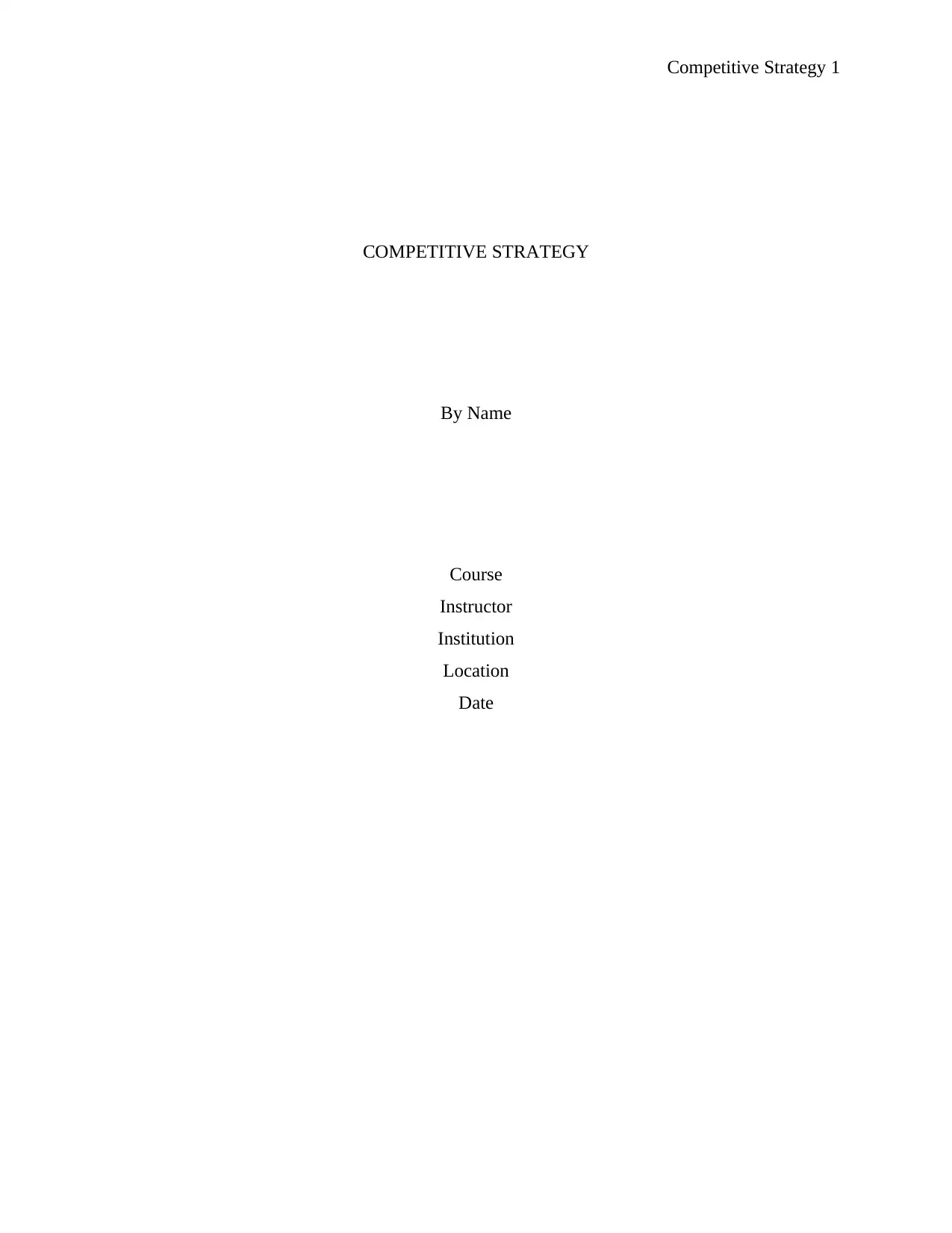
Competitive Strategy 1
COMPETITIVE STRATEGY
By Name
Course
Instructor
Institution
Location
Date
COMPETITIVE STRATEGY
By Name
Course
Instructor
Institution
Location
Date
Paraphrase This Document
Need a fresh take? Get an instant paraphrase of this document with our AI Paraphraser
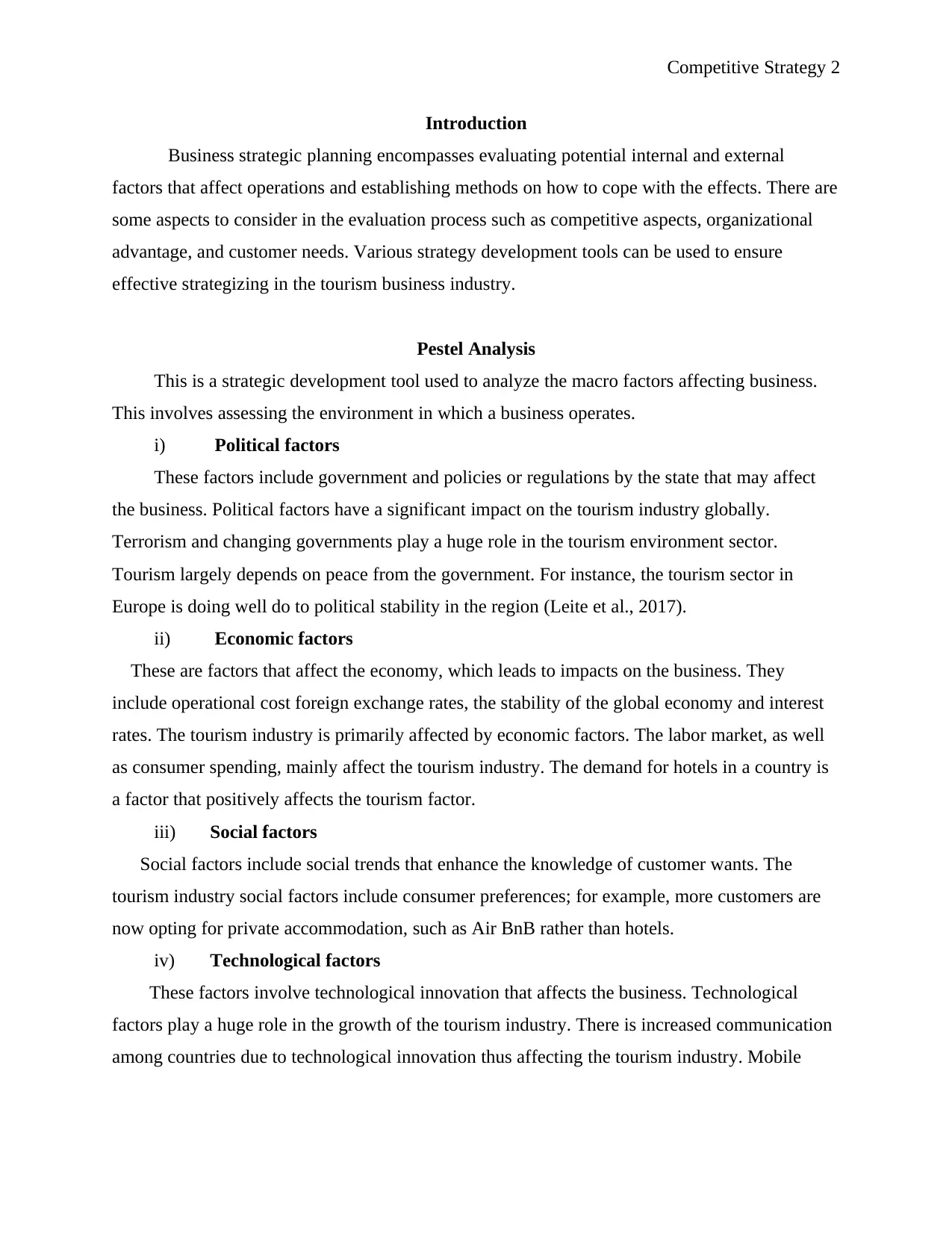
Competitive Strategy 2
Introduction
Business strategic planning encompasses evaluating potential internal and external
factors that affect operations and establishing methods on how to cope with the effects. There are
some aspects to consider in the evaluation process such as competitive aspects, organizational
advantage, and customer needs. Various strategy development tools can be used to ensure
effective strategizing in the tourism business industry.
Pestel Analysis
This is a strategic development tool used to analyze the macro factors affecting business.
This involves assessing the environment in which a business operates.
i) Political factors
These factors include government and policies or regulations by the state that may affect
the business. Political factors have a significant impact on the tourism industry globally.
Terrorism and changing governments play a huge role in the tourism environment sector.
Tourism largely depends on peace from the government. For instance, the tourism sector in
Europe is doing well do to political stability in the region (Leite et al., 2017).
ii) Economic factors
These are factors that affect the economy, which leads to impacts on the business. They
include operational cost foreign exchange rates, the stability of the global economy and interest
rates. The tourism industry is primarily affected by economic factors. The labor market, as well
as consumer spending, mainly affect the tourism industry. The demand for hotels in a country is
a factor that positively affects the tourism factor.
iii) Social factors
Social factors include social trends that enhance the knowledge of customer wants. The
tourism industry social factors include consumer preferences; for example, more customers are
now opting for private accommodation, such as Air BnB rather than hotels.
iv) Technological factors
These factors involve technological innovation that affects the business. Technological
factors play a huge role in the growth of the tourism industry. There is increased communication
among countries due to technological innovation thus affecting the tourism industry. Mobile
Introduction
Business strategic planning encompasses evaluating potential internal and external
factors that affect operations and establishing methods on how to cope with the effects. There are
some aspects to consider in the evaluation process such as competitive aspects, organizational
advantage, and customer needs. Various strategy development tools can be used to ensure
effective strategizing in the tourism business industry.
Pestel Analysis
This is a strategic development tool used to analyze the macro factors affecting business.
This involves assessing the environment in which a business operates.
i) Political factors
These factors include government and policies or regulations by the state that may affect
the business. Political factors have a significant impact on the tourism industry globally.
Terrorism and changing governments play a huge role in the tourism environment sector.
Tourism largely depends on peace from the government. For instance, the tourism sector in
Europe is doing well do to political stability in the region (Leite et al., 2017).
ii) Economic factors
These are factors that affect the economy, which leads to impacts on the business. They
include operational cost foreign exchange rates, the stability of the global economy and interest
rates. The tourism industry is primarily affected by economic factors. The labor market, as well
as consumer spending, mainly affect the tourism industry. The demand for hotels in a country is
a factor that positively affects the tourism factor.
iii) Social factors
Social factors include social trends that enhance the knowledge of customer wants. The
tourism industry social factors include consumer preferences; for example, more customers are
now opting for private accommodation, such as Air BnB rather than hotels.
iv) Technological factors
These factors involve technological innovation that affects the business. Technological
factors play a huge role in the growth of the tourism industry. There is increased communication
among countries due to technological innovation thus affecting the tourism industry. Mobile
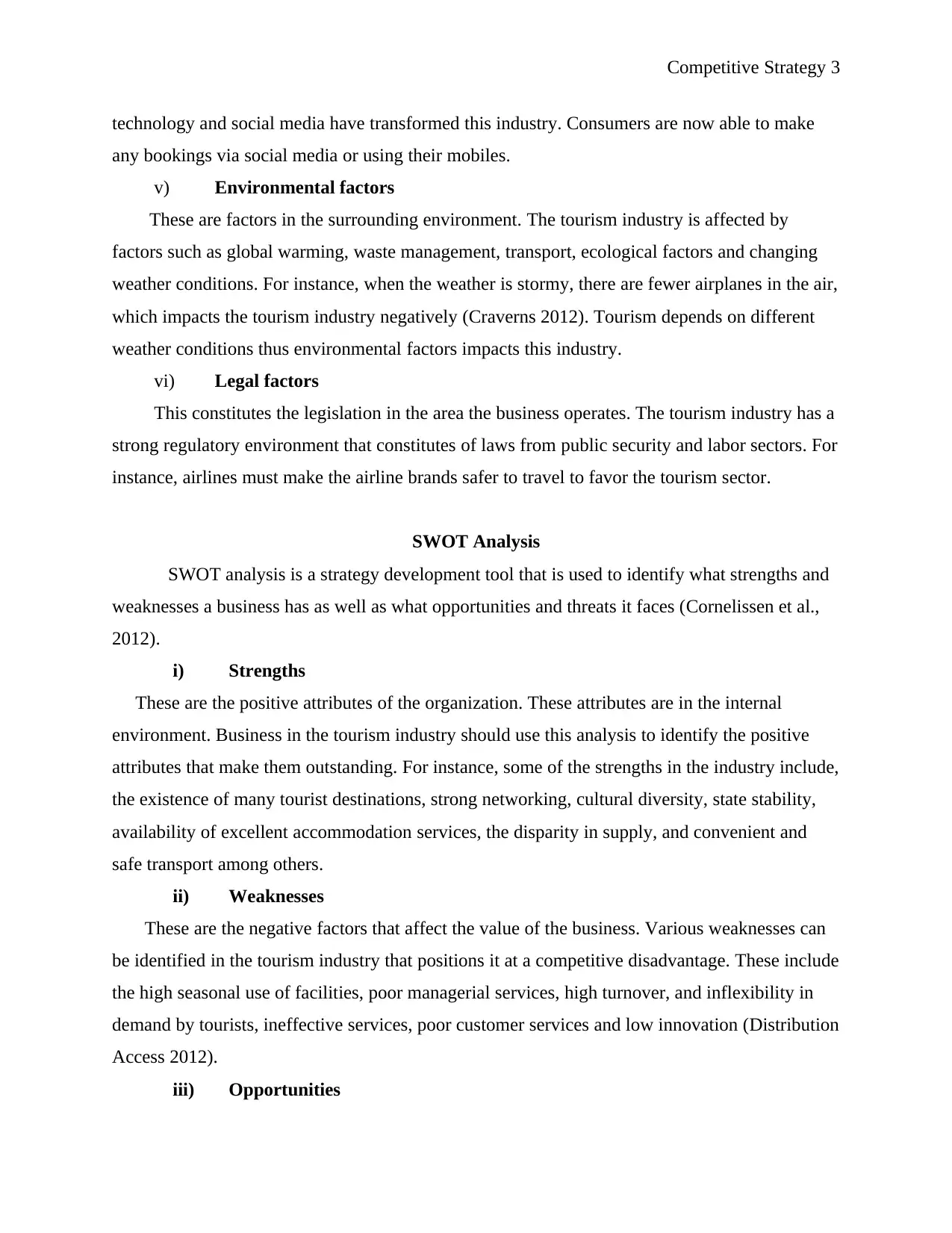
Competitive Strategy 3
technology and social media have transformed this industry. Consumers are now able to make
any bookings via social media or using their mobiles.
v) Environmental factors
These are factors in the surrounding environment. The tourism industry is affected by
factors such as global warming, waste management, transport, ecological factors and changing
weather conditions. For instance, when the weather is stormy, there are fewer airplanes in the air,
which impacts the tourism industry negatively (Craverns 2012). Tourism depends on different
weather conditions thus environmental factors impacts this industry.
vi) Legal factors
This constitutes the legislation in the area the business operates. The tourism industry has a
strong regulatory environment that constitutes of laws from public security and labor sectors. For
instance, airlines must make the airline brands safer to travel to favor the tourism sector.
SWOT Analysis
SWOT analysis is a strategy development tool that is used to identify what strengths and
weaknesses a business has as well as what opportunities and threats it faces (Cornelissen et al.,
2012).
i) Strengths
These are the positive attributes of the organization. These attributes are in the internal
environment. Business in the tourism industry should use this analysis to identify the positive
attributes that make them outstanding. For instance, some of the strengths in the industry include,
the existence of many tourist destinations, strong networking, cultural diversity, state stability,
availability of excellent accommodation services, the disparity in supply, and convenient and
safe transport among others.
ii) Weaknesses
These are the negative factors that affect the value of the business. Various weaknesses can
be identified in the tourism industry that positions it at a competitive disadvantage. These include
the high seasonal use of facilities, poor managerial services, high turnover, and inflexibility in
demand by tourists, ineffective services, poor customer services and low innovation (Distribution
Access 2012).
iii) Opportunities
technology and social media have transformed this industry. Consumers are now able to make
any bookings via social media or using their mobiles.
v) Environmental factors
These are factors in the surrounding environment. The tourism industry is affected by
factors such as global warming, waste management, transport, ecological factors and changing
weather conditions. For instance, when the weather is stormy, there are fewer airplanes in the air,
which impacts the tourism industry negatively (Craverns 2012). Tourism depends on different
weather conditions thus environmental factors impacts this industry.
vi) Legal factors
This constitutes the legislation in the area the business operates. The tourism industry has a
strong regulatory environment that constitutes of laws from public security and labor sectors. For
instance, airlines must make the airline brands safer to travel to favor the tourism sector.
SWOT Analysis
SWOT analysis is a strategy development tool that is used to identify what strengths and
weaknesses a business has as well as what opportunities and threats it faces (Cornelissen et al.,
2012).
i) Strengths
These are the positive attributes of the organization. These attributes are in the internal
environment. Business in the tourism industry should use this analysis to identify the positive
attributes that make them outstanding. For instance, some of the strengths in the industry include,
the existence of many tourist destinations, strong networking, cultural diversity, state stability,
availability of excellent accommodation services, the disparity in supply, and convenient and
safe transport among others.
ii) Weaknesses
These are the negative factors that affect the value of the business. Various weaknesses can
be identified in the tourism industry that positions it at a competitive disadvantage. These include
the high seasonal use of facilities, poor managerial services, high turnover, and inflexibility in
demand by tourists, ineffective services, poor customer services and low innovation (Distribution
Access 2012).
iii) Opportunities
⊘ This is a preview!⊘
Do you want full access?
Subscribe today to unlock all pages.

Trusted by 1+ million students worldwide
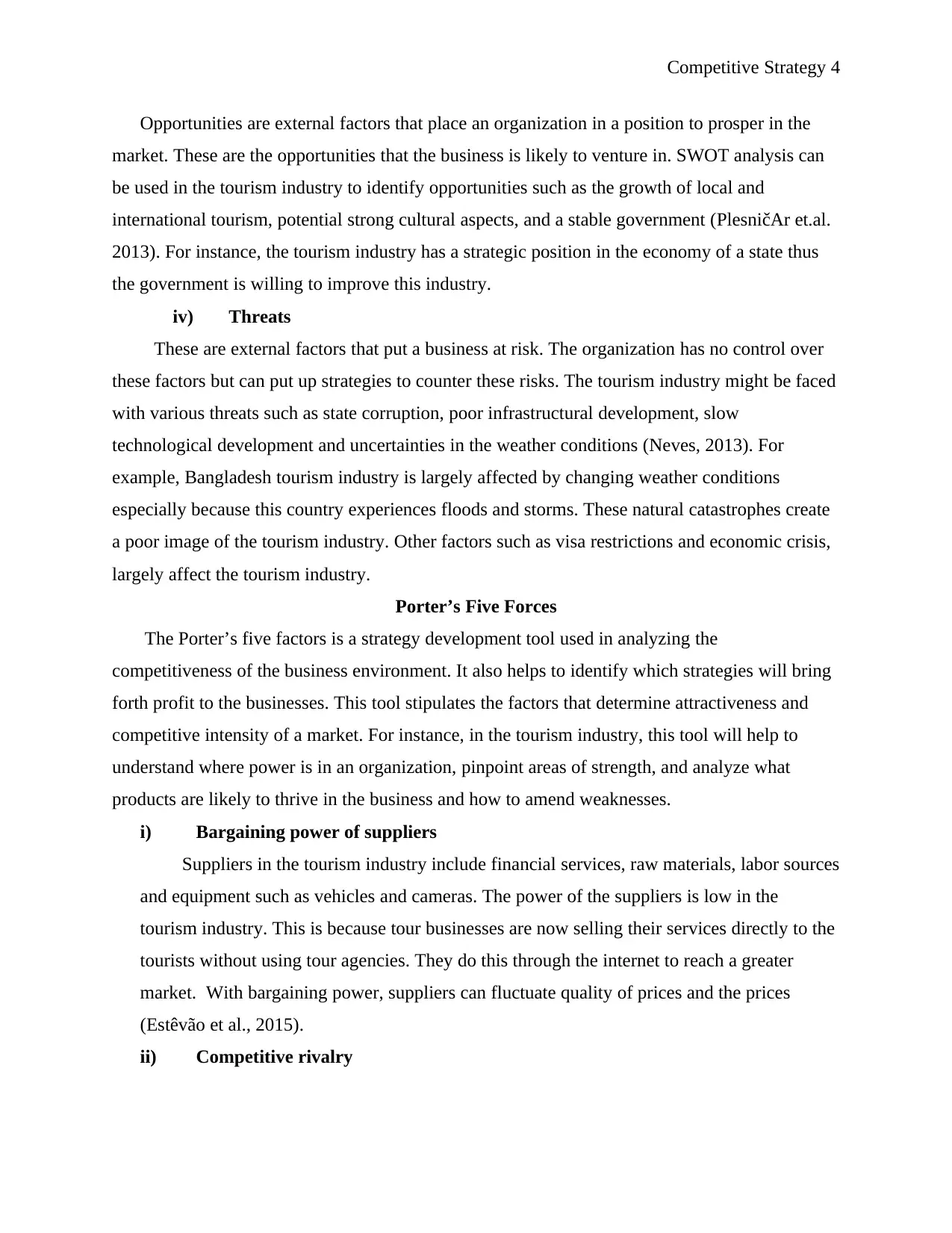
Competitive Strategy 4
Opportunities are external factors that place an organization in a position to prosper in the
market. These are the opportunities that the business is likely to venture in. SWOT analysis can
be used in the tourism industry to identify opportunities such as the growth of local and
international tourism, potential strong cultural aspects, and a stable government (PlesničAr et.al.
2013). For instance, the tourism industry has a strategic position in the economy of a state thus
the government is willing to improve this industry.
iv) Threats
These are external factors that put a business at risk. The organization has no control over
these factors but can put up strategies to counter these risks. The tourism industry might be faced
with various threats such as state corruption, poor infrastructural development, slow
technological development and uncertainties in the weather conditions (Neves, 2013). For
example, Bangladesh tourism industry is largely affected by changing weather conditions
especially because this country experiences floods and storms. These natural catastrophes create
a poor image of the tourism industry. Other factors such as visa restrictions and economic crisis,
largely affect the tourism industry.
Porter’s Five Forces
The Porter’s five factors is a strategy development tool used in analyzing the
competitiveness of the business environment. It also helps to identify which strategies will bring
forth profit to the businesses. This tool stipulates the factors that determine attractiveness and
competitive intensity of a market. For instance, in the tourism industry, this tool will help to
understand where power is in an organization, pinpoint areas of strength, and analyze what
products are likely to thrive in the business and how to amend weaknesses.
i) Bargaining power of suppliers
Suppliers in the tourism industry include financial services, raw materials, labor sources
and equipment such as vehicles and cameras. The power of the suppliers is low in the
tourism industry. This is because tour businesses are now selling their services directly to the
tourists without using tour agencies. They do this through the internet to reach a greater
market. With bargaining power, suppliers can fluctuate quality of prices and the prices
(Estêvão et al., 2015).
ii) Competitive rivalry
Opportunities are external factors that place an organization in a position to prosper in the
market. These are the opportunities that the business is likely to venture in. SWOT analysis can
be used in the tourism industry to identify opportunities such as the growth of local and
international tourism, potential strong cultural aspects, and a stable government (PlesničAr et.al.
2013). For instance, the tourism industry has a strategic position in the economy of a state thus
the government is willing to improve this industry.
iv) Threats
These are external factors that put a business at risk. The organization has no control over
these factors but can put up strategies to counter these risks. The tourism industry might be faced
with various threats such as state corruption, poor infrastructural development, slow
technological development and uncertainties in the weather conditions (Neves, 2013). For
example, Bangladesh tourism industry is largely affected by changing weather conditions
especially because this country experiences floods and storms. These natural catastrophes create
a poor image of the tourism industry. Other factors such as visa restrictions and economic crisis,
largely affect the tourism industry.
Porter’s Five Forces
The Porter’s five factors is a strategy development tool used in analyzing the
competitiveness of the business environment. It also helps to identify which strategies will bring
forth profit to the businesses. This tool stipulates the factors that determine attractiveness and
competitive intensity of a market. For instance, in the tourism industry, this tool will help to
understand where power is in an organization, pinpoint areas of strength, and analyze what
products are likely to thrive in the business and how to amend weaknesses.
i) Bargaining power of suppliers
Suppliers in the tourism industry include financial services, raw materials, labor sources
and equipment such as vehicles and cameras. The power of the suppliers is low in the
tourism industry. This is because tour businesses are now selling their services directly to the
tourists without using tour agencies. They do this through the internet to reach a greater
market. With bargaining power, suppliers can fluctuate quality of prices and the prices
(Estêvão et al., 2015).
ii) Competitive rivalry
Paraphrase This Document
Need a fresh take? Get an instant paraphrase of this document with our AI Paraphraser
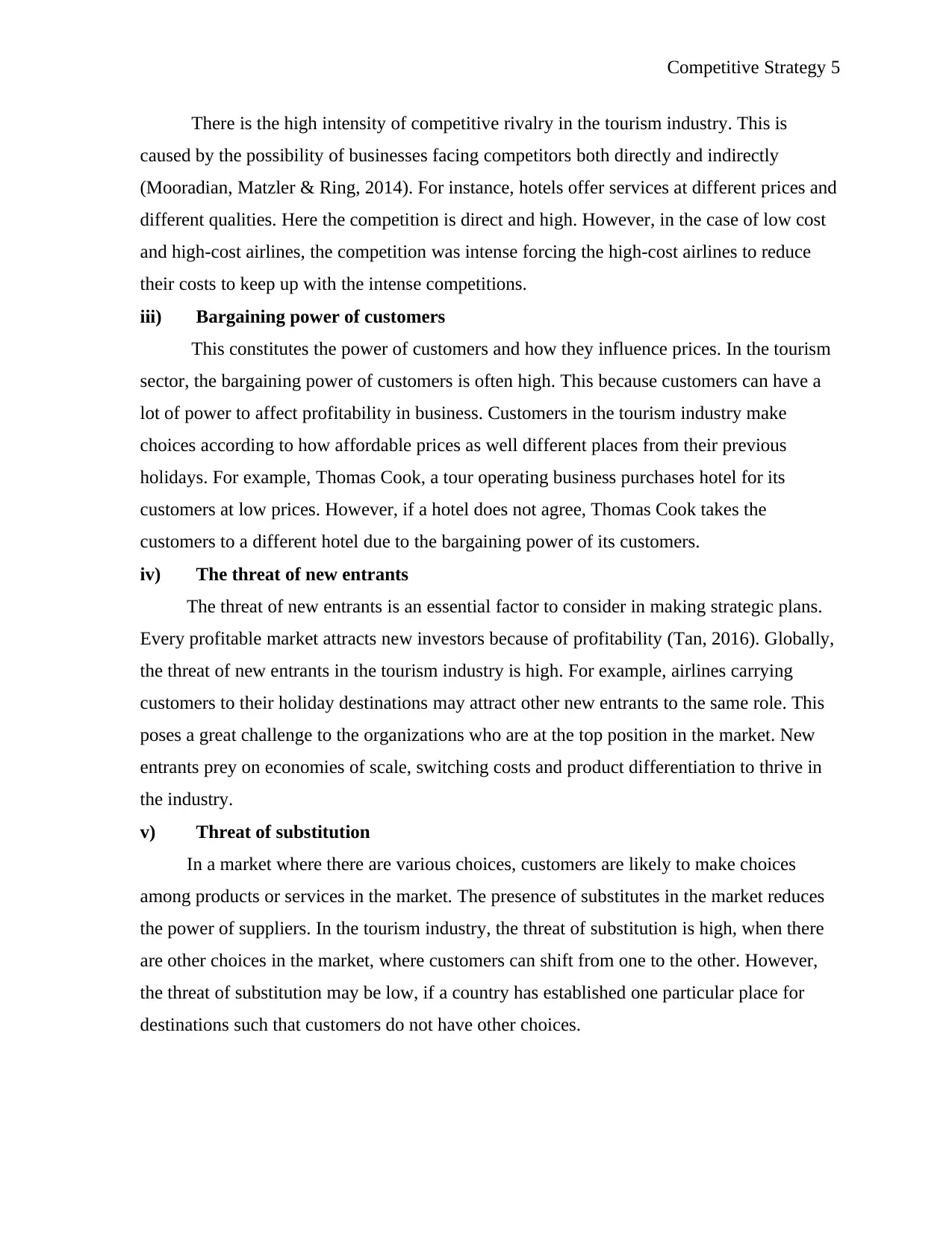
Competitive Strategy 5
There is the high intensity of competitive rivalry in the tourism industry. This is
caused by the possibility of businesses facing competitors both directly and indirectly
(Mooradian, Matzler & Ring, 2014). For instance, hotels offer services at different prices and
different qualities. Here the competition is direct and high. However, in the case of low cost
and high-cost airlines, the competition was intense forcing the high-cost airlines to reduce
their costs to keep up with the intense competitions.
iii) Bargaining power of customers
This constitutes the power of customers and how they influence prices. In the tourism
sector, the bargaining power of customers is often high. This because customers can have a
lot of power to affect profitability in business. Customers in the tourism industry make
choices according to how affordable prices as well different places from their previous
holidays. For example, Thomas Cook, a tour operating business purchases hotel for its
customers at low prices. However, if a hotel does not agree, Thomas Cook takes the
customers to a different hotel due to the bargaining power of its customers.
iv) The threat of new entrants
The threat of new entrants is an essential factor to consider in making strategic plans.
Every profitable market attracts new investors because of profitability (Tan, 2016). Globally,
the threat of new entrants in the tourism industry is high. For example, airlines carrying
customers to their holiday destinations may attract other new entrants to the same role. This
poses a great challenge to the organizations who are at the top position in the market. New
entrants prey on economies of scale, switching costs and product differentiation to thrive in
the industry.
v) Threat of substitution
In a market where there are various choices, customers are likely to make choices
among products or services in the market. The presence of substitutes in the market reduces
the power of suppliers. In the tourism industry, the threat of substitution is high, when there
are other choices in the market, where customers can shift from one to the other. However,
the threat of substitution may be low, if a country has established one particular place for
destinations such that customers do not have other choices.
There is the high intensity of competitive rivalry in the tourism industry. This is
caused by the possibility of businesses facing competitors both directly and indirectly
(Mooradian, Matzler & Ring, 2014). For instance, hotels offer services at different prices and
different qualities. Here the competition is direct and high. However, in the case of low cost
and high-cost airlines, the competition was intense forcing the high-cost airlines to reduce
their costs to keep up with the intense competitions.
iii) Bargaining power of customers
This constitutes the power of customers and how they influence prices. In the tourism
sector, the bargaining power of customers is often high. This because customers can have a
lot of power to affect profitability in business. Customers in the tourism industry make
choices according to how affordable prices as well different places from their previous
holidays. For example, Thomas Cook, a tour operating business purchases hotel for its
customers at low prices. However, if a hotel does not agree, Thomas Cook takes the
customers to a different hotel due to the bargaining power of its customers.
iv) The threat of new entrants
The threat of new entrants is an essential factor to consider in making strategic plans.
Every profitable market attracts new investors because of profitability (Tan, 2016). Globally,
the threat of new entrants in the tourism industry is high. For example, airlines carrying
customers to their holiday destinations may attract other new entrants to the same role. This
poses a great challenge to the organizations who are at the top position in the market. New
entrants prey on economies of scale, switching costs and product differentiation to thrive in
the industry.
v) Threat of substitution
In a market where there are various choices, customers are likely to make choices
among products or services in the market. The presence of substitutes in the market reduces
the power of suppliers. In the tourism industry, the threat of substitution is high, when there
are other choices in the market, where customers can shift from one to the other. However,
the threat of substitution may be low, if a country has established one particular place for
destinations such that customers do not have other choices.
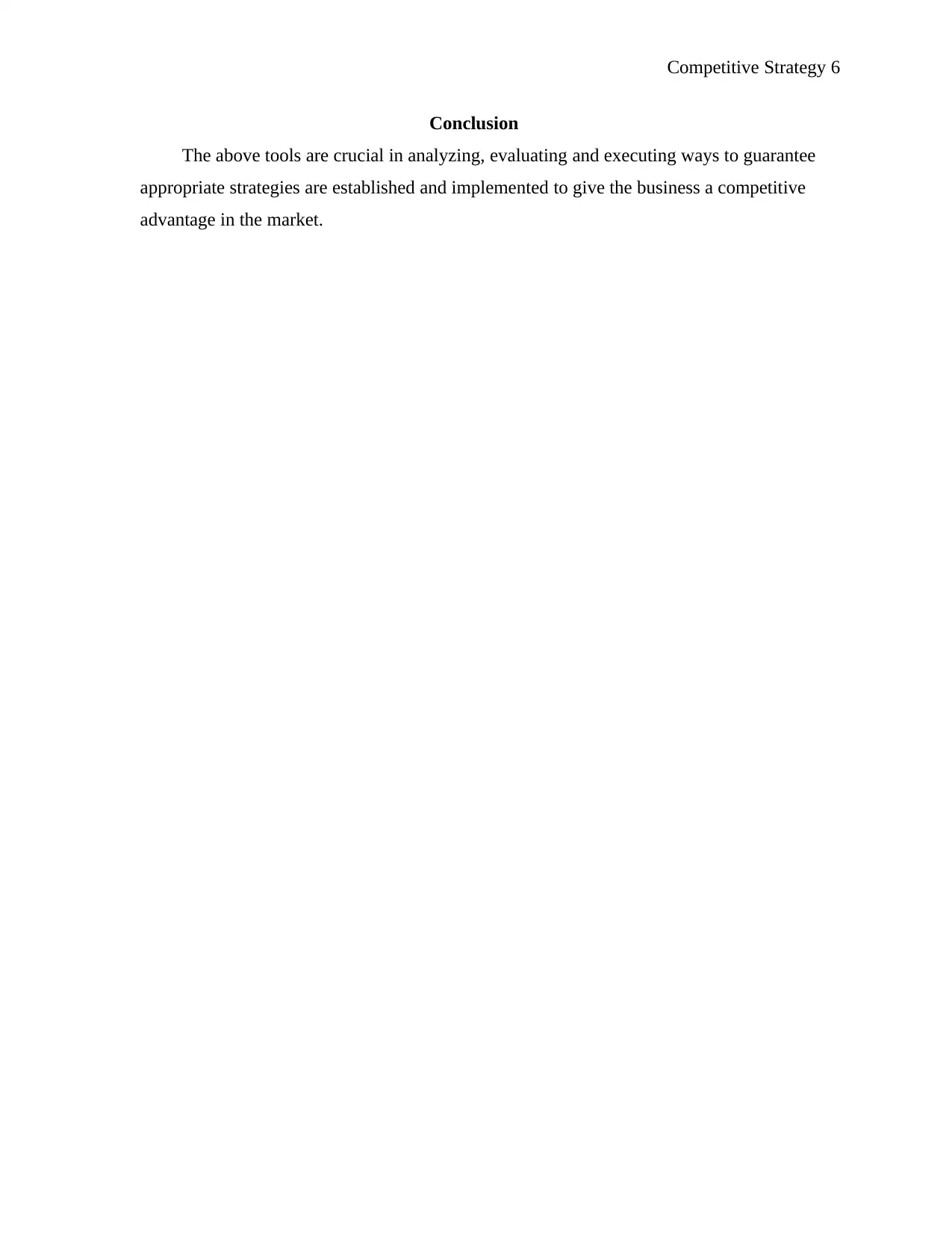
Competitive Strategy 6
Conclusion
The above tools are crucial in analyzing, evaluating and executing ways to guarantee
appropriate strategies are established and implemented to give the business a competitive
advantage in the market.
Conclusion
The above tools are crucial in analyzing, evaluating and executing ways to guarantee
appropriate strategies are established and implemented to give the business a competitive
advantage in the market.
⊘ This is a preview!⊘
Do you want full access?
Subscribe today to unlock all pages.

Trusted by 1+ million students worldwide
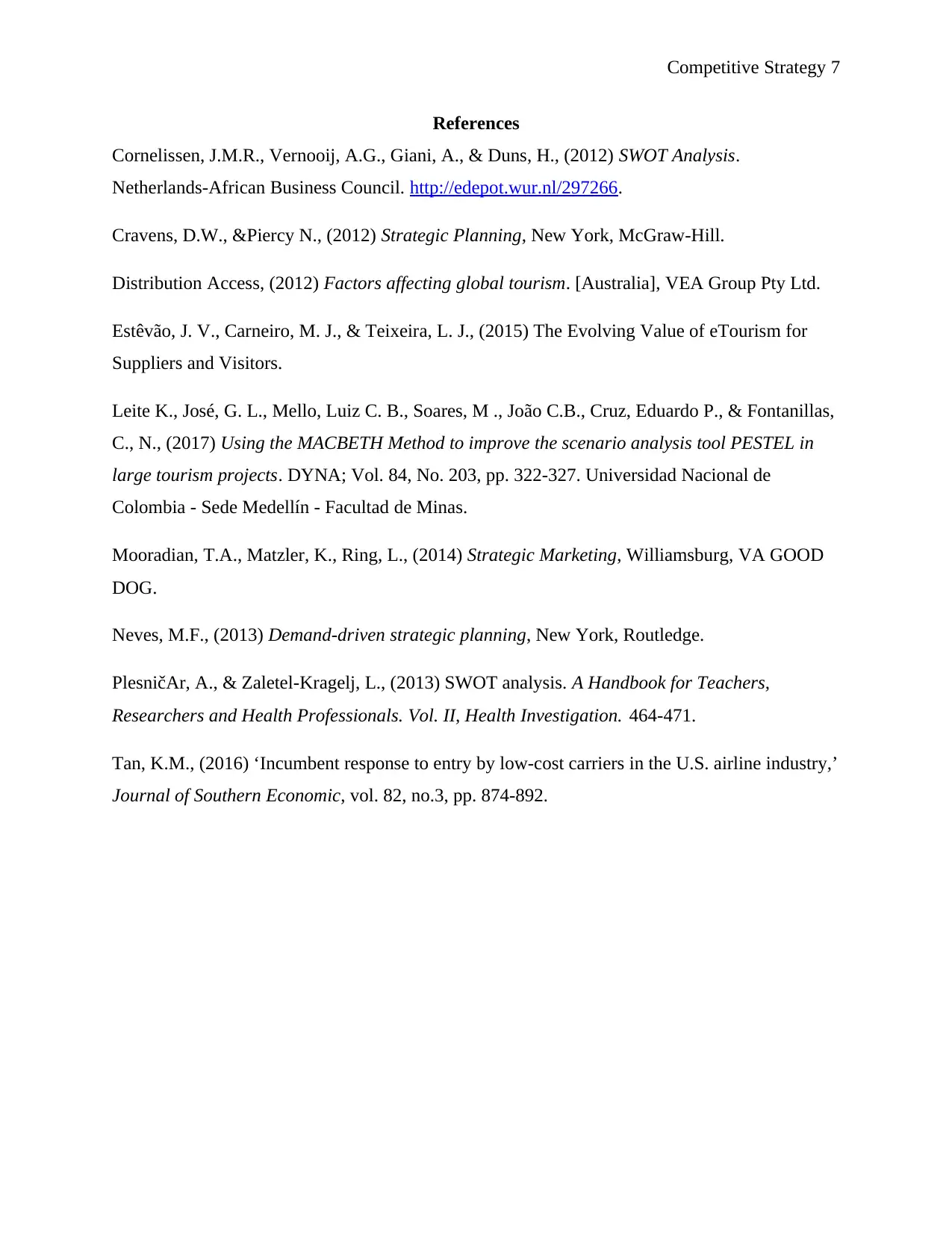
Competitive Strategy 7
References
Cornelissen, J.M.R., Vernooij, A.G., Giani, A., & Duns, H., (2012) SWOT Analysis.
Netherlands-African Business Council. http://edepot.wur.nl/297266.
Cravens, D.W., &Piercy N., (2012) Strategic Planning, New York, McGraw-Hill.
Distribution Access, (2012) Factors affecting global tourism. [Australia], VEA Group Pty Ltd.
Estêvão, J. V., Carneiro, M. J., & Teixeira, L. J., (2015) The Evolving Value of eTourism for
Suppliers and Visitors.
Leite K., José, G. L., Mello, Luiz C. B., Soares, M ., Jo ão C.B., Cruz, Eduardo P., & Fontanillas,
C., N., (2017) Using the MACBETH Method to improve the scenario analysis tool PESTEL in
large tourism projects. DYNA; Vol. 84, No. 203, pp. 322-327. Universidad Nacional de
Colombia - Sede Medellín - Facultad de Minas.
Mooradian, T.A., Matzler, K., Ring, L., (2014) Strategic Marketing, Williamsburg, VA GOOD
DOG.
Neves, M.F., (2013) Demand-driven strategic planning, New York, Routledge.
PlesničAr, A., & Zaletel-Kragelj, L., (2013) SWOT analysis. A Handbook for Teachers,
Researchers and Health Professionals. Vol. II, Health Investigation. 464-471.
Tan, K.M., (2016) ‘Incumbent response to entry by low-cost carriers in the U.S. airline industry,’
Journal of Southern Economic, vol. 82, no.3, pp. 874-892.
References
Cornelissen, J.M.R., Vernooij, A.G., Giani, A., & Duns, H., (2012) SWOT Analysis.
Netherlands-African Business Council. http://edepot.wur.nl/297266.
Cravens, D.W., &Piercy N., (2012) Strategic Planning, New York, McGraw-Hill.
Distribution Access, (2012) Factors affecting global tourism. [Australia], VEA Group Pty Ltd.
Estêvão, J. V., Carneiro, M. J., & Teixeira, L. J., (2015) The Evolving Value of eTourism for
Suppliers and Visitors.
Leite K., José, G. L., Mello, Luiz C. B., Soares, M ., Jo ão C.B., Cruz, Eduardo P., & Fontanillas,
C., N., (2017) Using the MACBETH Method to improve the scenario analysis tool PESTEL in
large tourism projects. DYNA; Vol. 84, No. 203, pp. 322-327. Universidad Nacional de
Colombia - Sede Medellín - Facultad de Minas.
Mooradian, T.A., Matzler, K., Ring, L., (2014) Strategic Marketing, Williamsburg, VA GOOD
DOG.
Neves, M.F., (2013) Demand-driven strategic planning, New York, Routledge.
PlesničAr, A., & Zaletel-Kragelj, L., (2013) SWOT analysis. A Handbook for Teachers,
Researchers and Health Professionals. Vol. II, Health Investigation. 464-471.
Tan, K.M., (2016) ‘Incumbent response to entry by low-cost carriers in the U.S. airline industry,’
Journal of Southern Economic, vol. 82, no.3, pp. 874-892.
1 out of 7
Related Documents
Your All-in-One AI-Powered Toolkit for Academic Success.
+13062052269
info@desklib.com
Available 24*7 on WhatsApp / Email
![[object Object]](/_next/static/media/star-bottom.7253800d.svg)
Unlock your academic potential
Copyright © 2020–2025 A2Z Services. All Rights Reserved. Developed and managed by ZUCOL.





